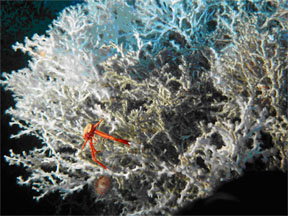|
|
| Line 1: |
Line 1: |
| − | ==Biogeomorphology of aquatic systems== | + | ==Biodiversity in the European Seas== |
| | | | |
| − | [[Image:zoninggeobiointeraction.jpg|thumb|right|250px| Fig.6 Illustrates how biota act as ecosystem engineers and influence sediment stability and morphology in the intertidal zone.]][[Biogeomorphology]] considers the interactions between the ecology and geomorphology of a system. Ecology is the study of relationships between the biota and their environment, and geomorphology examines landforms and how they are formed. Biogeomorphology can be studied in terrestrial as well as aquatic systems. Within aquatic systems biogeomorphological relationships can be found for both hard substrates (rocky shores / coral reefs) and soft substrates (muddy / sandy coastal sediments). Biota can alter geomorphology by creating hard substrates (e.g. coral reefs) or by modifying the stability or erodability of soft substrates. Key species in the benthic communities of sediment shores can influence geomorphology by acting as '''biostabilizers''' or '''biodestabilizers''' of sediment. The impact of organisms on coastal morphology can be both dramatic (e.g. coral reefs, [[salt marsh|saltmarshes]], mussel beds) and more subtle by modifying rates of sediment [[erosion]] and accretion. | + | [[Image:Lophelia.jpg|thumb|right|300px|''Lophelia pertusa'' Author: S. Ross ''et al.'', UNCW (www.safmc.net)]] This article summarises the [[Biodiversity_in_the_valuation_concept|biodiversity]] in the European Seas. It is based on [http://reports.eea.europa.eu/report_2002_0524_154909/en reports (publish date: 31 may 2002) of the ‘European Environmental Agency’ (visited 31/08/2007)]([[European Environmental Agency (EEA)|EEA]]), in which the marine biodiversity of each European sea is described in some detail. In the ‘EEA reports’ an overview is given of the most important physical, biological and exploitation characteristics, the main threats to biodiversity and the policies at work (nature protection and protection of marine resources by restrictions on fishing and hunting).The contents of these reports are shown together with an indication of the most relevant information. |
Revision as of 13:23, 19 February 2008
Biodiversity in the European Seas

Lophelia pertusa Author: S. Ross
et al., UNCW (www.safmc.net)
This article summarises the
biodiversity in the European Seas. It is based on
reports (publish date: 31 may 2002) of the ‘European Environmental Agency’ (visited 31/08/2007)(
EEA), in which the marine biodiversity of each European sea is described in some detail. In the ‘EEA reports’ an overview is given of the most important physical, biological and exploitation characteristics, the main threats to biodiversity and the policies at work (nature protection and protection of marine resources by restrictions on fishing and hunting).The contents of these reports are shown together with an indication of the most relevant information.
